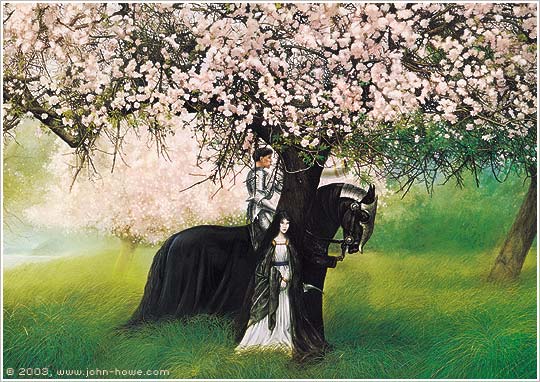In Geoffrey of MonmouthAccording to Geoffrey in the Historia and much subsequent literature which he inspired, Avalon is the place where King Arthur is taken after fighting Mordred at the Battle of Camlann to recover from his wounds. Welsh, Cornish and Breton tradition claimed that Arthur had never really died, but would inexorably return to lead his people against their enemies as discussed in King Arthur's messianic return.
The Historia also states that Avalon is where his sword Caliburn (Excalibur) was forged. Geoffrey dealt with Avalon in more detail in Vita Merlini, in which he describes for the first time in Arthurian legend the enchantress Morgan le Fay as the chief of nine sisters who live on Avalon. Geoffrey's description of the island indicates a sea voyage was needed to get there. His description of Avalon here, which is heavily indebted to the early medieval Spanish scholar Isidore of Seville , shows the magical nature of the island:
The island of apples which men call “The Fortunate Isle” (Insula Pomorum que Fortunata uocatur) gets its name from the fact that it produces all things of itself; the fields there have no need of the ploughs of the farmers and all cultivation is lacking except what nature provides. Of its own accord it produces grain and grapes, and apple trees grow in its woods from the close-clipped grass. The ground of its own accord produces everything instead of merely grass, and people live there a hundred years or more. There nine sisters rule by a pleasing set of laws those who come to them from our country.[1]
By comparison, Isidore's description of the Fortunate Isles reads:
"The name of the Isles of the Fortunate signifies that they bear all good things, as if happy and blessed in the abundance of their fruits. Serviceable by nature, they bring forth fruits of valuable forests (Sua enim aptae natura pretiosarum poma silvarum parturiunt); their hilltops are clothed with vines growing by chance; in place of grasses, there is commonly vegetable and grain. Pagan error and the songs of the secular poets have held that these islands to be Paradise because of the fecundity of the soil. Situated in the Ocean to the left of Mauretania, very near the west, they are separated by the sea flowing between them."

In medieval times suggestions for the location of Avalon ranged far beyond Glastonbury. They included on the other side of the Earth at the antipodes, Sicily and other unnamed locations in the Mediterranean. In more recent times, just like in the quest for Arthur's mythical capital Camelot, a large number of locations have been put forward as being the real 'Avalon'.
These theories include l'Île d'Aval or Daval, on the coast of Brittany, and Burgh by Sands, in Cumberland, which was in Roman times the fort of Aballava on Hadrian's Wall, and near Camboglanna, upwards on the Eden, now Castlesteads. According to Welsh tradition (as first recorded in the 10th century Annales Cambriae, but also found in numerous later sources), Arthur was killed in battle at a site named Camlann, which may be etymologically related to Camboglanna, though this is by no means certain. Other candidates include the Bourgogne town of Avallon, suggested by Geoffrey Ashe, as part of his theory connecting the Romano-British king, Riothamus, to King Arthur, and Bardsey Island in Gwynedd, famous for its apples and also connected with Merlin. Others have claimed the most likely location to be St Michael's Mount in Cornwall, which is near to other locations associated with the Arthurian legends. St Michael's Mount is an island which can be reached by a causeway at low tide. The matter is confused somewhat by similar legends and place names in Brittany.

Avalon also plays a role in non-Arthurian French literature, such as the stories of Holger Danske, who was taken there by Morgan le Fay in a medieval romance, and in the story of Melusine. It also recurs in a number of later works without other connection to King Arthur. During the 17th century, the area surrounding one of North America's first European settlements Ferryland, was named after the legendary isle.
Originally called the Province of Avalon, in modern times it is known as the Avalon Peninsula in the Canadian province of Newfoundland and Labrador.